Intestinal Parasites in Today’s World
Intestinal parasites are a worldwide epidemic not limited to populations in developing countries or those who travel to exotic locales. Recent studies suggest that 1 in 3 Americans are living with a parasitic infection of some kind. Moreover, in North America the most prevalent kind of parasitic infections are gastrointestinal in nature. Time and again, in my practice, I see patients who present with a prolonged period of abdominal pain, diarrhea, loss of appetite, weight loss, fatigue and anemia and, after testing them it becomes evident that they are suffering from an intestinal parasite. Today, I want to share with you the most common intestinal parasites and the symptoms these organisms can cause to help you decipher whether you may be suffering from an intestinal parasite. Moreover, I want to show you the ways which, in my practice of over thirty years, I have successfully treated intestinal parasites and brought great relief to my patients.
What Are Parasites?
A parasite is an organism that lives on or within another organism (a host), getting its nourishment from and at the expense of the host organism. Parasites cause many diseases for humans, which can involve the digestive tract, major organs, tissues, blood and the nervous system. There are three main classes of parasites that affect humans; protozoa, helminths and ectoparasites. Protozoa are microscopic, one celled organisms that can live with our without a host. Protozoa often take up residence in the intestinal track causing distressing gastrointestinal symptoms such diarrhea, abdominal pain, nausea, vomiting, etc. Helminths are multi-cellular organisms that are usually visible to the naked eye. Helminths often reside in the gastrointestinal track, though they are also found in blood, and other tissues throughout the rest of the body. Like protozoa they can live free of a host and they cause uncomfortable and serious gastrointestinal issues. Ectoparasites refer to organisms such as ticks, fleas, lice and mites. While these parasites do not usually end up in the gastrointestinal track, the diseases they carry can cause life-altering gastrointestinal issues and symptoms.
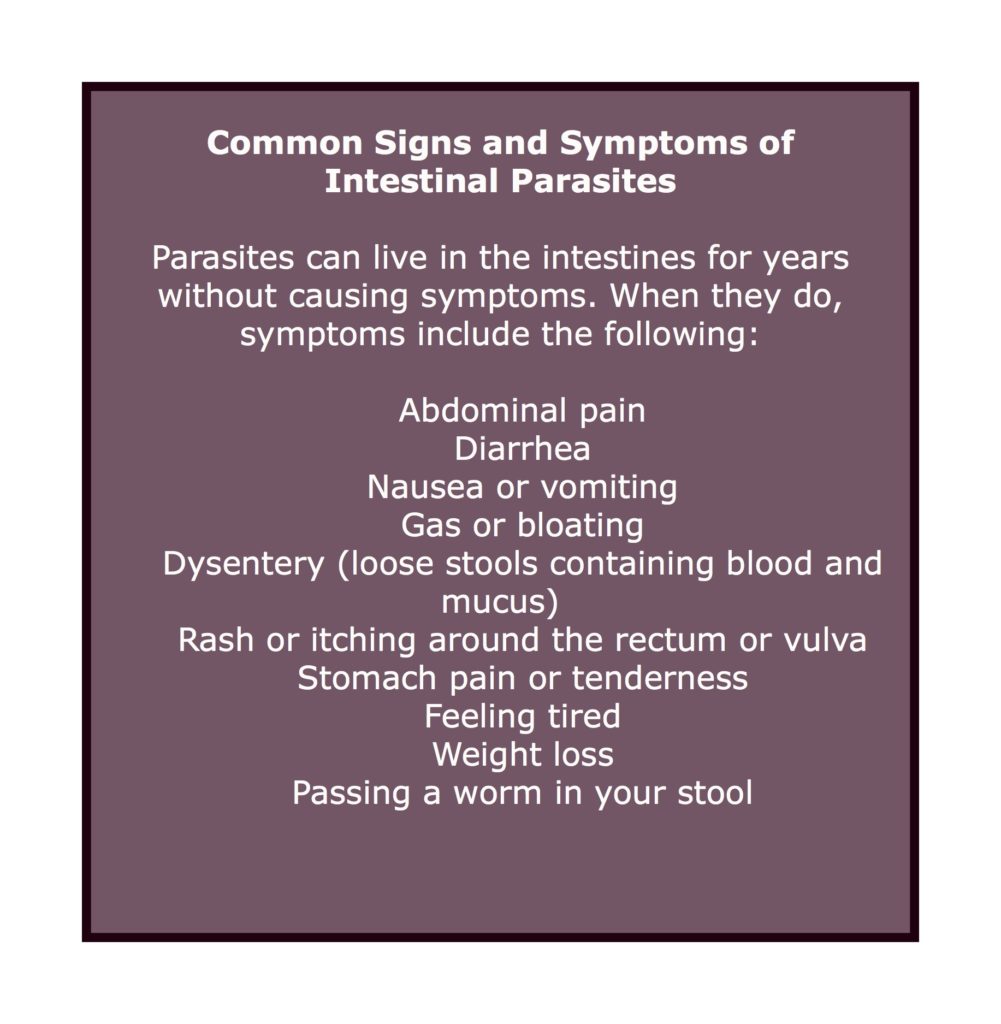
Types of Intestinal Parasites
Hookworm (Ancylostoma duodenale and Necator americanus)
Hookworm is an intestinal parasite that lives in the small intestine of humans and causes rashes, diarrhea, nausea, abdominal pain, weakness and anemia, and it can even impair the physical and cognitive growth of children. A person can become host to a hookworm parasite if their skin comes in contact with hookworm larvae. When this occurs, the small, immature worms penetrate the skin and make their way to the gastrointestinal tract. Hookworm is also caught via the fecal-oral route when one accidentally ingests dirt, water or produce infected with hookworm larvae (usually as a result of any of the following; infected human stool being used as fertilizer, a lack of good sanitation and a lack of cleanliness). Most adult worms are expelled from the small intestine after one to two years, although they can wreak havoc on the digestive system and cause chronic anemia during this time.
Cyclospora (Cyclospora cayetanensis)
Clyclospora are single celled, microscopic organisms that invade the small intestine causing symptoms such as cramping, watery diarrhea, weight loss, bloating, increased gas, nausea, fatigue, vomiting and low-grade fever. Clyclospora is transmitted via the fecal-oral route (infected fecal mater ingested accidentally usually via soil, food or water). This parasite is most often found in tropical and sub-tropical climates. Sometimes, this parasite makes its way to North America on produce that has been shipped from various at-risk regions in the world, creating outbreaks in the U.S. and Canada.
Roundworm (Ascaris lumbricoides)
Roundworms can be found in various parts of the body but they are mostly found in the lungs and digestive tract. Symptoms of roundworm parasitic infection include coughing or gagging, vomiting roundworms, wheezing or shortness of breath, nausea, vomiting, irregular stools, visible worms in the stool, stomach or abdominal pain, weight loss and fatigue. Roundworm infections are common the world over, but especially in hot, humid areas. They are transmitted via the fecal-oral route when one accidentally ingests soil, food or water contaminated with human fecal matter infected with roundworm eggs or larvae.
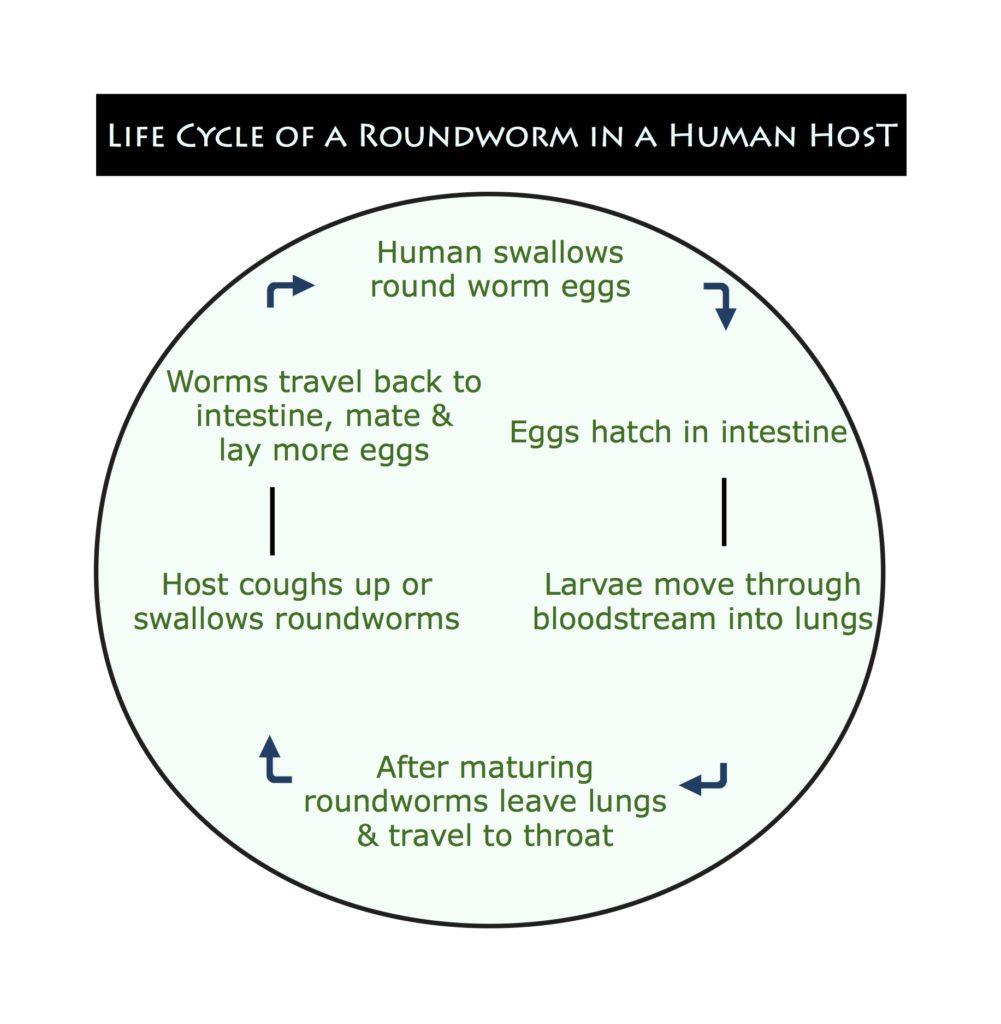
Whipworm (Trichuris trichiura)
Whipworm parasites are prevalent in both temperate and humid climates worldwide. Whipworm get their name from the distinctive whip-like shape of their bodies. They are spread through the ingestion of whipworm eggs, which make their way to the intestines where the eggs reside and then hatch into adult worms. Whipworm spreads via the fecal-oral route when individuals accidentally ingest soil, water or food that has been in contact with human fecal matter infected with whipworm eggs. People with smaller scale whip worm infections usually have no signs or symptoms but people with further developed infections experience painful, frequent diarrhea that has an acrid smell and contains a mixture of mucus, water, and blood.
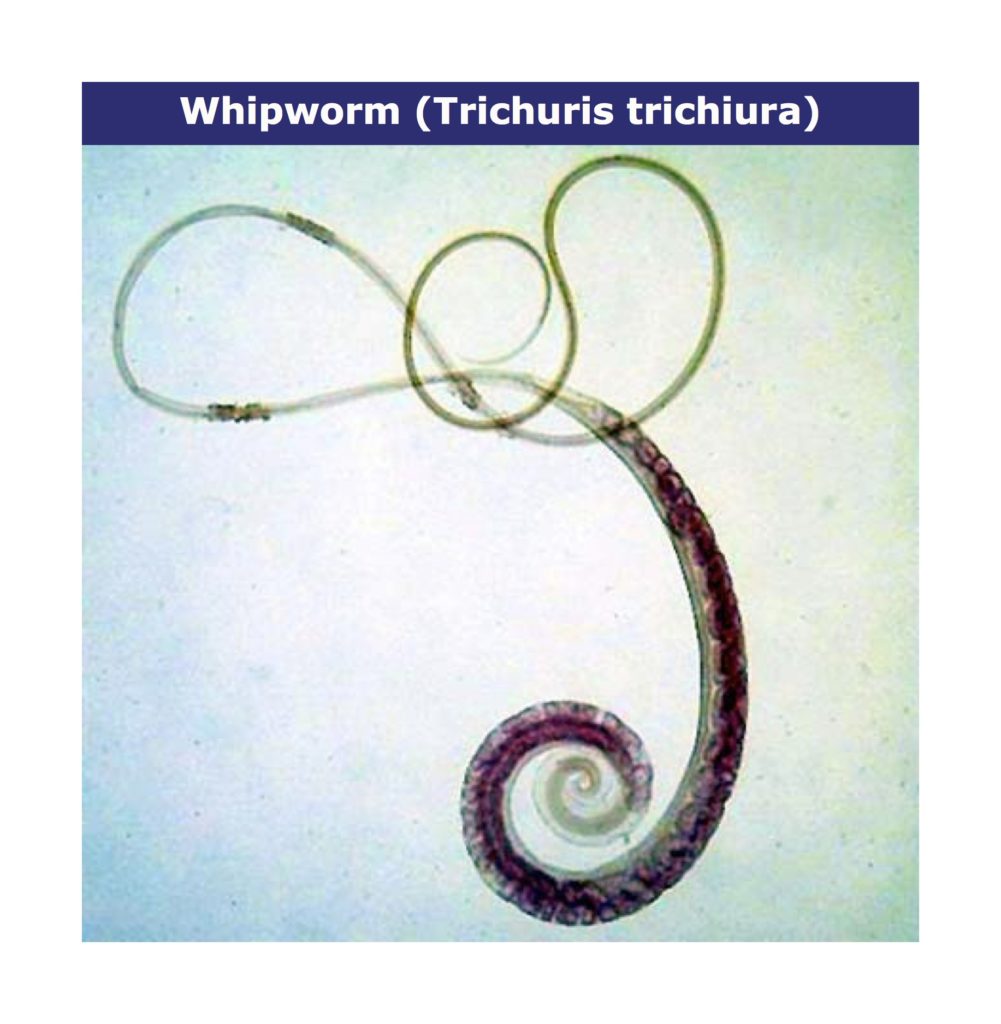
Blastocystosis (Blastocystis hominis)
Blastocytosis is a microscopic parasite that finds its way into the intestine of humans and animals, causing symptoms such as abdominal pain, diarrhea, constipation, gas, greasy stools and nausea. Blastocytosis is transmitted via the fecal-oral route when an individual accidentally ingests contaminated water, soil or food. It also survives on common surfaces in remnants of infected fecal matter and can be transmitted when one touches such surfaces and unknowingly ingests the parasite. Blastocytosis is a worldwide issue and recognized as a common cause of waterborne diseases in humans in the United States, affecting up to 23% of the population in the year 2000.
Tapeworm (Taenia solium)
Tapeworms can live in humans for up to 25 years and can cause symptoms such as diarrhea, abdominal pain, nausea, vomiting, loss or increase of appetite and/or weight loss. You can develop a tapeworm infection by ingesting undercooked beef, pork and fresh water fish infected with tapeworm eggs or larvae. You can also develop a tapeworm infection via the fecal-oral route from touching common surfaces or ingesting infected soil, food or water, which have come in contact with infected human stool. Tapeworms reside in the gastrointestinal tract of their human host, attaching themselves to the intestinal lining using the tiny hooks on their “heads” (scolex). One of the tell tale signs of a tapeworm infection is seeing bits of tapeworm in your stools.
Flatworm Blood Fluke (Schistosoma mansoni, S. haematobium, S. japonicum)
Flatworm blood flukes are tiny worm parasites that are found in bodies of fresh water throughout the world. Flatworm Blood Flukes attach themselves to human skin then penetrate the skin barrier and make their way into the bloodstream. This parasite can either not cause problems or it can cause a very serious disease called Schistosomiasis, (also called Bilharzia). Symptoms of schistosomiasis begin when eggs shed by adult worms do not pass out of the body and become stuck in the intestine causing inflammation and/or scarring and a host of unpleasant gastrointestinal symptoms such as bloody stools, abdominal pain and weight loss. After years of infection, the parasite can also damage the liver, spleen, lungs, and bladder.
Pinworms (Enterobius vermicularis)
Adult pinworms are about 0.5 inches long and live in the human digestive track. Individuals become infected by pinworms via the fecal-oral route by accidentally swallowing pinworm eggs found on common surfaces. Pinworm is very common in schools and daycare centers. Once a host ingests pinworm eggs, the eggs move to the intestine and reside there until, about a month later when they hatch. After hatching, female pinworms crawl out of the host’s rectum (usually at night) and lay eggs around the outside of the anus. The unsuspecting host begins to suffer from itchiness around their rectum and after touching the area they accidently touch another surface, unknowingly spreading the pinworm eggs. Pinworms cause itchiness and irritation around the rectum.
Giardia (Giardia lamblia)
Giardia is a microscopic parasite that is found in soil, food and water, and also on common surfaces that have come in contact with infected feces from humans or animals. Giardia lives and breeds in the small intestine causing a serious intestinal illness called, giardiasis. During the process of this disease, inflammation and other damage to the intestine occurs reducing the gut’s ability to absorb nutrients and causing ongoing diarrhea, nausea, stomach pain and gas. Giardiasis is a global disease that infects 2% of adults and 6% – 8% of children in developed countries and nearly 33% of people in developing countries. In the United States, Giardia infection is the most common intestinal parasitic disease.
Entamoeba Histolytica
This single-celled parasitic organism infects predominately humans and primates and causes a possibly deadly disease called amoebiasis. Entamoeba Histolytica can be found in damp environments, water, soil and in contaminated fruits and vegetables. This tiny cyst-like parasite enters the body and makes its way to the gastrointestinal track to feed on cells in the human colon. As this parasite develops it causes a disease known as amoebiasis. This disease affects the gastrointestinal tract first causing symptoms ranging from bloody stools to abdominal pain, to weight loss to colonic ulcers. If this parasite manages to move through the host’s blood stream and reaches other organs in the body it can compromise other major organs and become deadly.
How to Prevent Getting Intestinal Parasites
Most intestinal parasites develop as a result of accidental skin contact or ingestion (fecal-oral route when soil, water, food or surfaces have come in contact with infected human or animal stool). Washing your hands regularly, ensuring your water source is clean, practicing good sanitation, cooking your meat and fish thoroughly are just some of the habits you need to practice to avoid getting and spreading intestinal parasites (please look at my diagram below for a full list of lifestyle habits that will help stop the spread of parasites). Finally, eating a healthy diet and using the proper amount and strains of probiotics keeps the immune system strong and better able to naturally fight off parasitic infections.
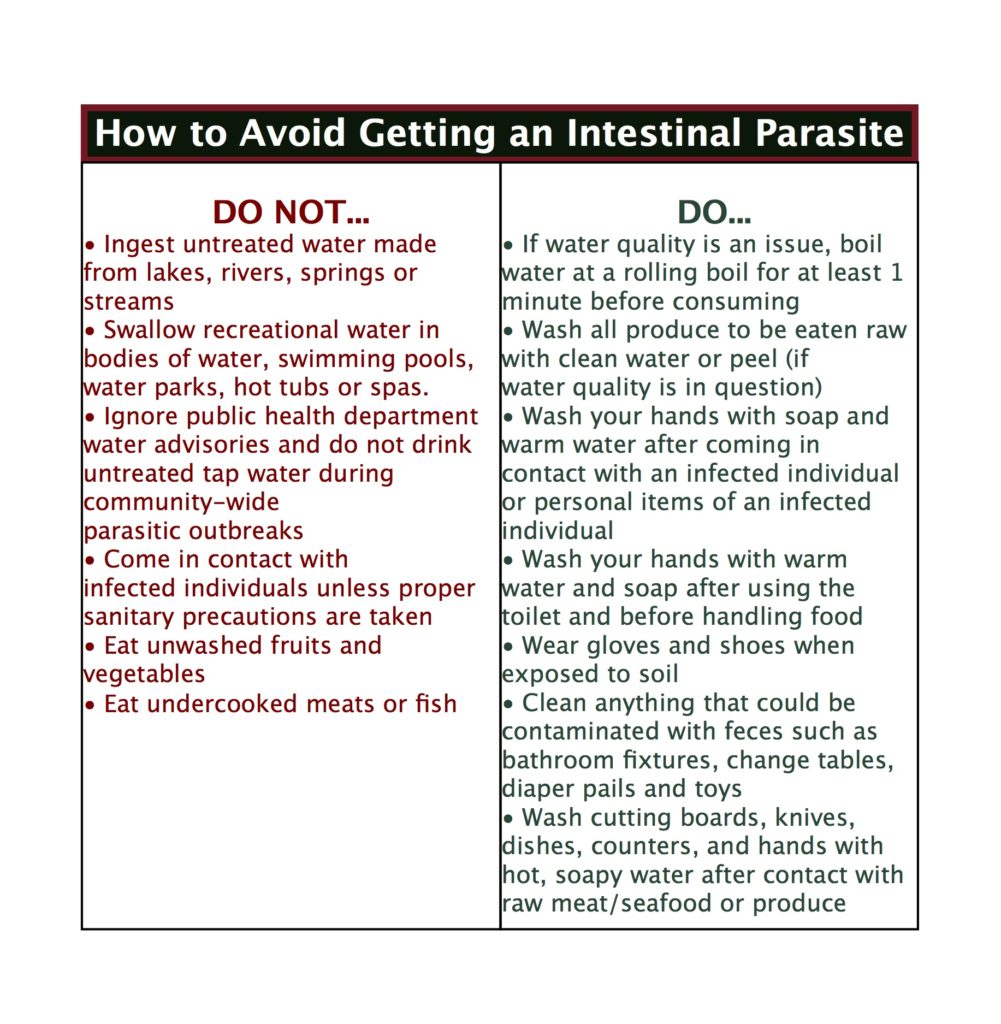
How to Diagnose Intestinal Parasites
When there is suspicion of parasitic infection in the gastrointestinal tract, traditional medical practitioners will test fecal matter and blood. While this works for some, many patients need testing that is more thorough and comprehensive. I diagnose patients using Doctor’s Data Comprehensive Stool Analysis X3 with Parasitology. This thorough, non-invasive methodology of testing is an excellent and dependable way to test patients to see if they are suffering from an intestinal parasite. This test is also incredibly helpful in diagnosing those experiencing nonspecific GI-related symptoms such as diarrhea, constipation, abdominal pain and nausea. For this at-home test, the patient follows instructions and uses specimen containers to gather three stool samples. The patient then sends these samples back to my lab where a diagnosis is made regarding the patient’s intestinal health. From there I create a treatment plan to address issues such as digestion, absorption, bacterial balance, parasitic presence, metabolism, inflammation, yeast overgrowth and immune function.
How to Treat Intestinal Parasites
Many parasites lay dormant for years and do not create symptoms in the body but when they do become symptomatic, the infection can often progress quickly and make an individual’s life very difficult. Doctors practicing traditional medicine usually prescribe antibiotics to treat intestinal parasites. However, from my experience, I have noted that the use of antibiotics and antiparasitics can sometimes exacerbate GI issues. For this reason, I opt to treat my patients with the all-natural product, Para-Calm, a comprehensive and convenient all in one formula made from herbal agents and natural products that have antiparasitic and antimicrobial properties and have been historically proven to effectively treat parasitic infections in humans. I created Para-Calm twelve years ago to treat my in-office patients suffering with intestinal parasites. After the recommended course of this product (one three times a day with food for a period of four weeks), my patients are tested again using Doctor’s Data Comprehensive Stool Analysis X3 with Parasitology and in over 95% of cases there is no trace of intestinal parasites. For the remaining 5% (most of whom have multiple parasites or long-term infection), I recommend a second four week program. While my patients take Para-Calm I encourage them to eat a healthy diet full of lean meats and fresh produce to help stabilize and promote healthy gut enzymes.
Many also use Para-Calm as a yearly parasite cleanse. This popular and convenient prevention/treatment protocol is done once or twice a year (for four weeks) as part of a good wellness plan!
Para-Calm’s Natural Ingredients Are Historically Proven to Treat Intestinal Parasites
Every Para-Calm capsule contains the highest quality, targeted, natural herbal ingredients that have powerful antiparasitic and antimicrobial properties. This formula was created using the optimal balance of Sweet Wormwood/Artemisinin, Olive Leaf, Black Walnut Hulls, and Berberine Sulfate Hydrate. All of these ingredients are historically proven to effectively treat intestinal parasites.
Wormwood & Artemisinin
Wormwood is a herb commonly found throughout Asia. This fern like plant has powerful antiparasitic, antimicrobial and disease fighting properties that when extracted are able to effectively treat parasites such as malaria, Babesia species, Schistosoma species, Leishmania species, Toxoplasma gondii, and Plasmodium species. Wormwood is the source for the key ingredient for the herbal drug, artemisinin, which is one of the most powerful antimalarial treatments available. The World Health Organization (WHO) suggests artemisinin as the first line of defense against uncomplicated strands of malaria. Wormwood/Artemisinin is especially effective in treating pinworm (Enterobius vermicularis) and roundworm (Ascaris lumbricoides)
Olive Leaf Extract
The ancient Egyptians believed that Olive leaf extract, taken from the leaves of olive trees, had healing powers. In the late 1800’s scientific data about the anti-parasitic abilities of olive leaf extract emerged thanks to the successful use of this extract to counteract a deadly outbreak of Malaria. A key ingredient called Oleuropein, which is a bitter compound, plays an important role in the anti-bacterial, anti-viral, anti-fungal and anti-parasitic powers of olive leaf extract.
Black Walnut Hulls
Black Walnut hulls have been used in herbal medicine for thousands of years, dating back to the Roman Empire. They have powerful anti-viral, anti-fugal and anti-septic properties that make it a well-known property used to fight intestinal parasites. Black Walnut hulls help the body rid itself parasites by promoting regular bowel function. The high tannin and juglone content in Black Walnut hulls are believed to oxygenate the blood and kill parasites. It is effective against common intestinal parasites such as pinworm, ringworm and tapeworm, as well as other lesser-known intestinal parasites.
Berberine Sulfate Hydrate
Berberine is a powerful alkaloid, which is extracted from the roots of plants such as barberry, turmeric, and Oregon grape. Medical studies document that Berberine is an anti-parasitic agent that treats some of the most prevalent and aggressive parasites in the world. Berberine has been used to effectively treat certain strains of malaria and parasites such as Entamoeba histolytica, Giardia lamblia, Leishmania donovani, and Trichomonas vaginalis.
My Final Words On Intestinal Parasites
If you think you may be suffering from the signs and symptoms of an intestinal parasite, then I encourage you to contact me today. I am available by telemedicine (phone) or at our Integrative Medical Center. Using Doctor’s Data Comprehensive Stool Analysis X3 with Parasitology, I can help you determine whether or not you have an intestinal parasite. If you do have an intestinal parasite, you need not worry. My comprehensive and effective product, Para-Calm, can effectively treat your intestinal parasite and bring your body back to good health, just as it has done for so many of my patients over the past many years.
—
Alum A, Rubino JR, Ijaz MK. The global war against intestinal parasites–should we use a holistic approach? [Review]. Int J Infect Dis. 2010;14(9):e732-8.
Cappello M. Global health impact of soil-transmitted nematodes. Pediatr Infect Dis J. 2004;23:663–4. [PubMed]
Drake LJ, Jukes MCH, Sternberg RJ, Bunday DAP. Geohelminth infections (ascariasis, trichiuriasis, and hookworm): cognitive and development impacts. Sem Paediatr Infect Dis. 2000;11:245–51.
Davis AN, Haque R, Petri WA., Jr Update on protozoan parasites of the intestine. Curr Opin Gastroentrol. 2002;18:10–4. [PubMed]
Dinleyici EC, Eren M, Dogan N, Reyhanioglu S, Yargic ZA, Vandenplas Y. Clinical efficacy of Saccharomyces boulardii or metronidazole in symptomatic children with Blastocystis hominis infection. Parasitol Res. 2011;108(3):541-5
Farthing MJ. Treatment options for the eradication of intestinal protozoa. Nat Clin Pract Gastroenterol Hepatol. 2006;3(8):436-45.
Guarner F. Prebiotics, probiotics and helminths: the ‘natural’ solution? Dig Dis. 2009;27(3):412-7. Review.
Haque R, Mondal D, Kirkpatrick BD, Akther S, Farr BM, Sack RB. Epidemiologic and clinical characteristics of acute diarrhea with emphasis on Entamoeba histolytica infections in preschool children in an urban slum of Dhaka, Bangladesh. Am J Trop Med Hyg. 2003;69:398–405. [PubMed]
Haque R, Ali IK, Akther S, Petri WA., Jr Comparison of PCR, isoenzyme analysis, and antigen detection for diagnosis of Entamoeba histolytica infection. J Clin Microbiol. 1998;36:449–52. [PMC free article] [PubMed]
Haque, Rashidul. Human Intestinal Parasites. J Health Popul Nutr. 2007 Dec; 25(4): 387–391.
Leiva B, Lebbad M, Winiecka-Krusnell J, Altamirano I, Tellez A, Linder E. Overdiagnosis of Entamoeba histolytica and Entamoeba dispar in Nicaragua: a microscopic, triage parasite panel and PCR study. Arch Med Res. 2006;37:529–34. [PubMed]
Le Blancq SM, Adam RD. Structural basis of karyotype heterogeneity in Giardia lamblia. Mol Biochem Parasitol. 1998;97:199–208. [PubMed]
Mishra PK, Palma M, Bleich D, Loke P, Gause WC. Systemic impact of intestinal helminth infections. Mucosal Immunol. 2014;7(4):753-62.
Missaye A, Dagnew M, Alemu A, Alemu A. Prevalence of intestinal parasites and associated risk factors
Okhuysen PC, White AC., Jr Parasitic infections of the intestine. Curr Opin Infect Dis. 1999;12:467–72. [PubMed]
Weitzel T, Dittrich S, Möhl I, Adusu E, Jelinek T. Evaluation of seven commercial antigen detection tests for Giardia and Cryptosporidium in stool samples. Clin Microbiol
World Health Organization. Amoebiasis. WHO Weekly Epdemiol Rec. 1997;72:97–100.
World Health Organization. Prevention and control of schistosomiasis and soil-transmitted helminthiasis; report of a WHO expert committee. Geneva: World Health Organization; 2002. p. 63. WHO technical report series no. 912. [PubMed]
Gupta YK, Gupta M, Aneja S, Kohli K. Current drug therapy of protozoal diarrhoea. Indian J Pediatr. 2004;71:55–8. [PubMed]





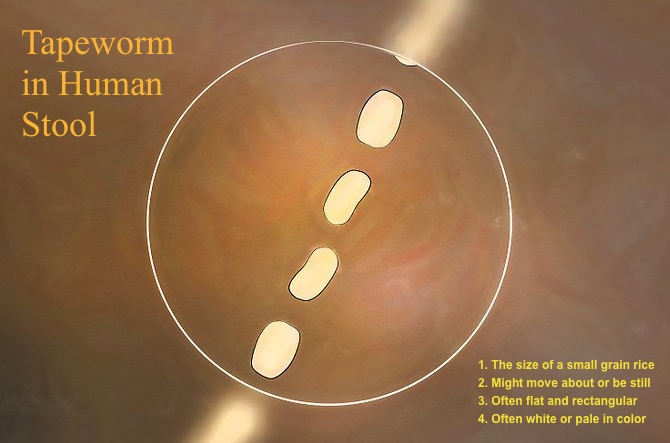



I hope that I finally found the doctor I need to help me I’ve been living a night mare I believe that I have a parasite . but because all my test are coming back negative .I cannot get any help so I’m suffering help me please my name is Anita
Hello Anita,
Thank you for contacting me. I am sorry to hear about your suffering.
In my experience, parasites are a common cause of illness, yet they are often overlooked. Fortunately, with proper testing, they are usually easy to diagnose and treat.
Please contact me through DM at drcraigmaxwell@roadrunner.com. I will be glad to schedule a telemedicine (phone) consultation with you. This includes a complete review of your medical history, any test results, and consultations. Further testing may be ordered if needed. My goal is to find, and treat, any underlying cause(s). A targeted, customized treatment plan is then recommended.
I look forward to helping you, Anita!
Warmest regards,
Dr. Maxwell